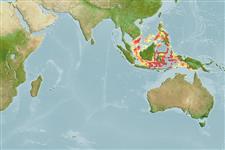>
Atheriniformes (Silversides) >
Phallostethidae (Priapiumfishes)
Etymology: Neostethus: Greek,neos = new + Greek, stetho, stethion = brest; literal = to prick a little breast (Ref. 45335).
More on author: Herre.
Environment: milieu / climate zone / depth range / distribution range
Ecologia
marinhas; Água doce; estuarina bentopelágico. Tropical
Asia: Mindanao, Cuyo, Mactan, Negros Oriental and Leyte, Philippines.
Tamanho / Peso / Idade
Maturity: Lm ? range ? - ? cm
Max length : 2.3 cm SL macho/indeterminado; (Ref. 12768)
Occur in mangrove and nipa swamps (Ref. 280). Fertilization is internal and eggs are attached to the substrate via adhesive filaments (Ref. 43413).
Ciclo de vida ou comportamento de acasalamento
Maturities | Reprodução | Spawnings | Egg(s) | Fecundities | Larvas
Pelvic fins in males are modified to form part of a complex thoracic clasping organ (Ref. 205).
Parenti, L.R., 1989. A phylogenetic revision of the phallostethid fishes (Atherinomorpha, Phallostethidae). Proc. Calif. Acad. Sci. 46(11):243-277. (Ref. 12768)
Status na Lista Vermelha da UICN (Ref. 130435)
Ameaça para os humanos
Harmless
Uso pelos humanos
Ferramentas
Relatórios especiais
Baixar XML
Fontes da internet
Estimates based on models
Preferred temperature (Ref.
123201): 28 - 29.1, mean 28.6 °C (based on 66 cells).
Índice de diversidade filogenética (Ref.
82804): PD
50 = 0.5002 [Uniqueness, from 0.5 = low to 2.0 = high].
Bayesian length-weight: a=0.00389 (0.00180 - 0.00842), b=3.12 (2.94 - 3.30), in cm total length, based on all LWR estimates for this body shape (Ref.
93245).
Nível Trófico (Ref.
69278): 3.0 ±0.3 se; based on size and trophs of closest relatives
Fishing Vulnerability (Ref.
59153): Low vulnerability (10 of 100).
